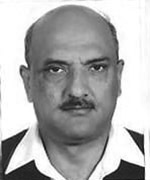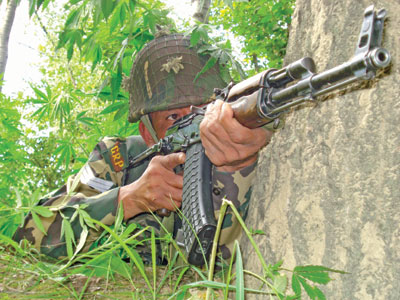The true potential of the CAPFs can be best achieved by bringing in urgent reforms
 S.K. Sood
S.K. Sood
India is a large country with myriad problems, both internal and external, which impinge upon the security of our country. We have long borders with our neighbours, two of whom, China and Pakistan, continue to remain hostile. The borders along other neighbouring countries, too, present several security challenges.
Internally, the country continues to battle many insurgencies. Starting from the Nagaland problem immediately after Independence, India had to face the Naxal menace in Seventies and Eighties followed by militancy in Punjab in the Eighties and Nineties. We are presently battling the Separatist movement in Jammu and Kashmir besides large-scale Maoist insurgency in central India.
Since defence forces cannot be utilised in every situation as it hampers their training and preparation for their original role, India is therefore required to maintain large security forces to tackle internal security challenges as well as peace-time border management.
Out of the five central armed forces under ministry of home affairs (MHA), three, the Border Security Force (BSF), Indo-Tibetan Border Police (ITBP) and Sashastra Seema Bal (SSB) are border guarding forces with additional responsibility of assisting the defence forces during hostilities. The other two namely, Central Reserve Police Force (CRPF) and Central Industrial Security Force (CISF) are responsible for assisting the civil administration in internal security and industrial security respectively. Two other armed forces namely Assam Rifles (AR) and Rashtriya Rifles (RR), although funded by MHA, operate under command ministry of defence with tasks of border guarding and internal security respectively.
Even though, the CRPF is designated specialised force for assisting the civil administration in internal security tasks, India being a very large country with diverse problems, other forces are frequently deployed for such tasks.
The Central Paramilitary Forces (CPMF), therefore, play a very important role in the security matrix of India. The border guarding forces, especially the BSF and ITBP, are the first line of defence of India with a specific war time role of assisting army in the war efforts. The BSF had performed admirably during the war in 1971. Subsequently, during the Kargil conflict, it was the area manned by the BSF which could not be infiltrated by Pakistanis as the BSF did not vacate the FDLs. In order to ensure their readiness for war time role, these forces practice it periodically during war games and exercises.
Recent developments in eastern Ladakh where the ITBP was deployed and the downing of an armed drone in Hiranagar sector in Jammu indicate that the adversary keeps adopting newer methods and therefore the CPMF must keep evolving in order to retain their edge. The evolution has to take into account the prevalent operational environment. All other aspects, viz equipment, training policies, personnel management etc have to be in consonance with the evolving operational philosophy. Therefore, the most important reform that these forces need to initiate is to create a perspective planning cell tasked to study future trends and make recommendations. None of these forces presently have such a setup hence, the reforms that take place are personality oriented rather than policy driven.
A mentally mobile leadership with deep insights into the operational environment and ethos will be the one that can ensure effectiveness of these forces. Simply acquiring newer and supposedly modern equipment is not adequate. The acquisitions have to match with the prevailing operational environment. Unfortunately, the concept of modernisation as perceived by the leadership is limited to acquiring more and more computers for offices and vehicles (especially light vehicles) which are mostly used for transportation of senior officers. The leadership has to think beyond that and ensure ease of operation by the foot soldier. The leadership has to find ways to reduce physical and mental burden on the men by effective adaptation of modern technology and intelligence gathering.
We need to assess the actual requirement of weapons and equipment according to the role required to be performed by a force in a particular area of deployment. The equipping policy has to shift from being vendor-driven to requirement-driven.
Some of the equipment presently acquired does not appear to be suited to the operational requirements and the tasks of the CPMF. For example, heavy weapons including high trajectory are not effective in the heavily-forested area where Maoist insurgency is spread because the splinters will get obstructed by trees. These will also not be effective in built-up area because of the threat of collateral damage. Additional weapons like rocket launchers, automatic grenade launchers keep getting demanded and authorised. This happens because of disconnect of policy level leaders with the capabilities and limitations of these weapons as well as with the theatre of operations.
Tendency to impose one solution to all situations is exemplified in the equipping policy of SSB. If analysed objectively, it will be a foregone conclusion that SSB doesn’t need heavy weaponry, especially the high trajectory weapons like 81mm mortars and MMGs because they man an open border. Moreover, being deployed along peaceful Nepal and Bhutan borders, there is no likelihood of a war breaking out with these countries. Unlike the Indo-Bangladesh and Indo-Pakistan border, the imposition of section 144 along these borders has no relevance because of the free movement regime. Even for the contingency of being assigned some war time responsibilities in case of hostilities with China, these weapons may be authorised centrally at appropriate level along with a trained pool of manpower which can be multitasked for normal border guarding duties.

This tendency is also implicit in the insistence on fencing all our borders including even the snow bound areas on the Line of Control (LC). While the plains of Punjab, Rajasthan and Gujarat are amenable to effective fencing, same is not true for almost the entire border with Bangladesh. Here 1,000km (out of 4,000km) of border is riverine and has many areas where the population could not be relocated to safer areas from close to International Border (IB).
The use of information technology in the forces continues to suffer from false starts and is personality driven. The emphasis on its use varies according to the technical knowhow of the commander. The information technology, which should be used to create data bank to analyse operational performance, threat perceptions, crime pattern etc., has so far been used mainly for limited administrative purposes.
In so far as border guarding forces are concerned, we need to focus on developing/ acquiring effective surveillance equipment which give us adequate early warning to enable proper response in required time frame. The present manpower intensive domination system has to be replaced with intelligent domination methodology which will ensure adequate rest and relief to troops and also effective border crime control. The domination system has to change from deployment of men all along the borders in small teams to QRT (Quick Reaction Team) system located at Border Outposts (BOPs) for reaction on being given early warning by a control room monitoring the inputs from surveillance devices placed along borders/ border fence.
You must be logged in to view this content.

